Abstract
The effects of rectal distension on upper gastrointestinal motility were investigated in six healthy subjects. On a control day, gastric and duodenal motor activity was recorded for nine hours of fasting and for four hours after a meal, duodeno-caecal transit being assessed in both interdigestive and digestive states. Motor activity and transit were also measured on a test day during which the rectum was distended for one hour during fasting and for one hour postprandially. Control and test days were randomised. During fasting, rectal distension increased the incidence of migrating motor complexes (0.8 +/- 0.3 v 0.5 +/- 0.2 h; p less than 0.01) and reduced the duodenal phase 2 motility index to 66 +/- 45% of that observed on the control day (p less than 0.01). Further, duodeno-caecal transit time was increased by rectal distension (99 +/- 30 v 71 +/- 35 min; p less than 0.05). Postprandially, the period of rectal distension was marked by a reduction in the duodenal motility index to 24 +/- 13% of that observed during the comparable period on the control day (p less than 0.001) and a concomitant increase in duodeno-caecal transit time (113 +/- 22 v 80 +/- 17 min; p less than 0.01). We conclude that upper gastrointestinal motor activity, the effector of luminal transit, may be profoundly influenced by stimulation of distal afferents.
Full text
PDF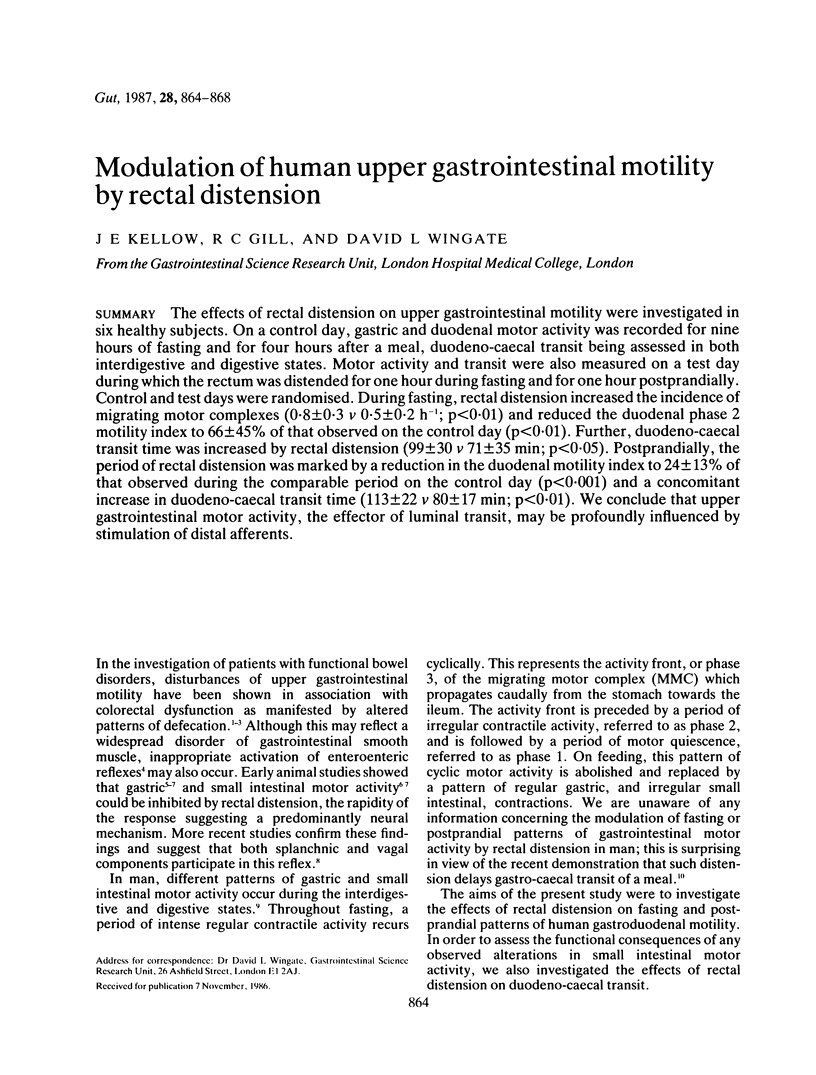
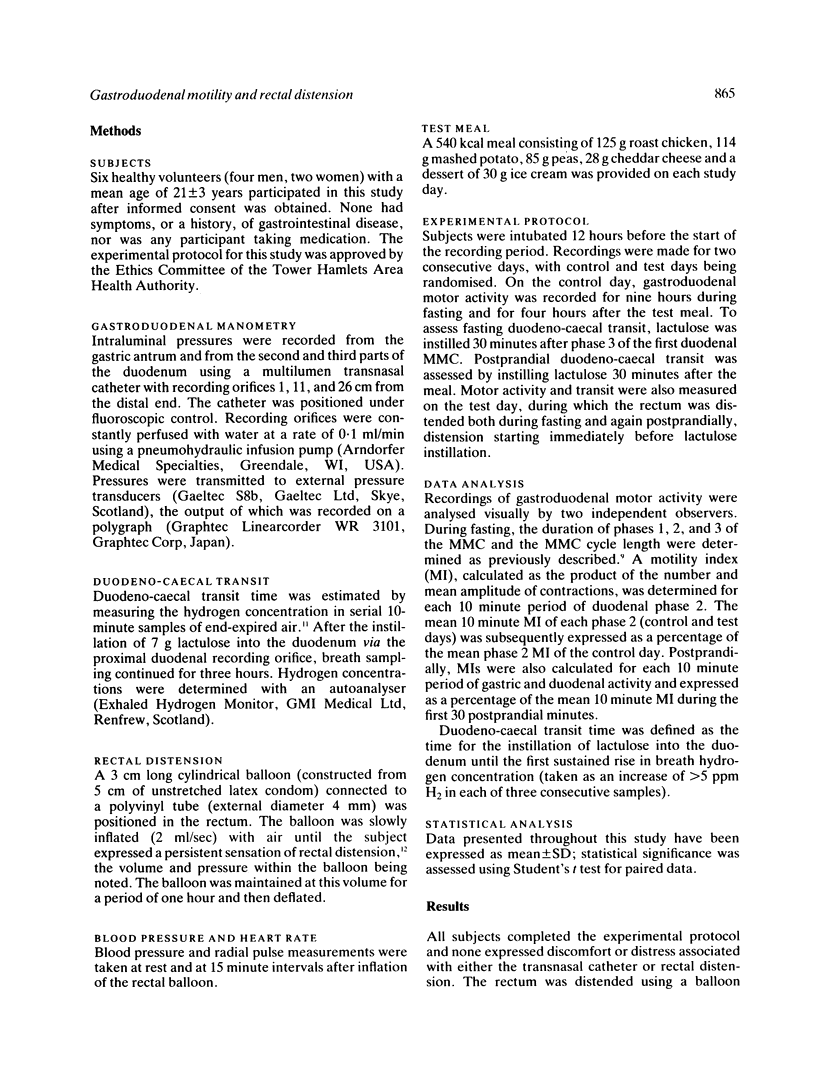
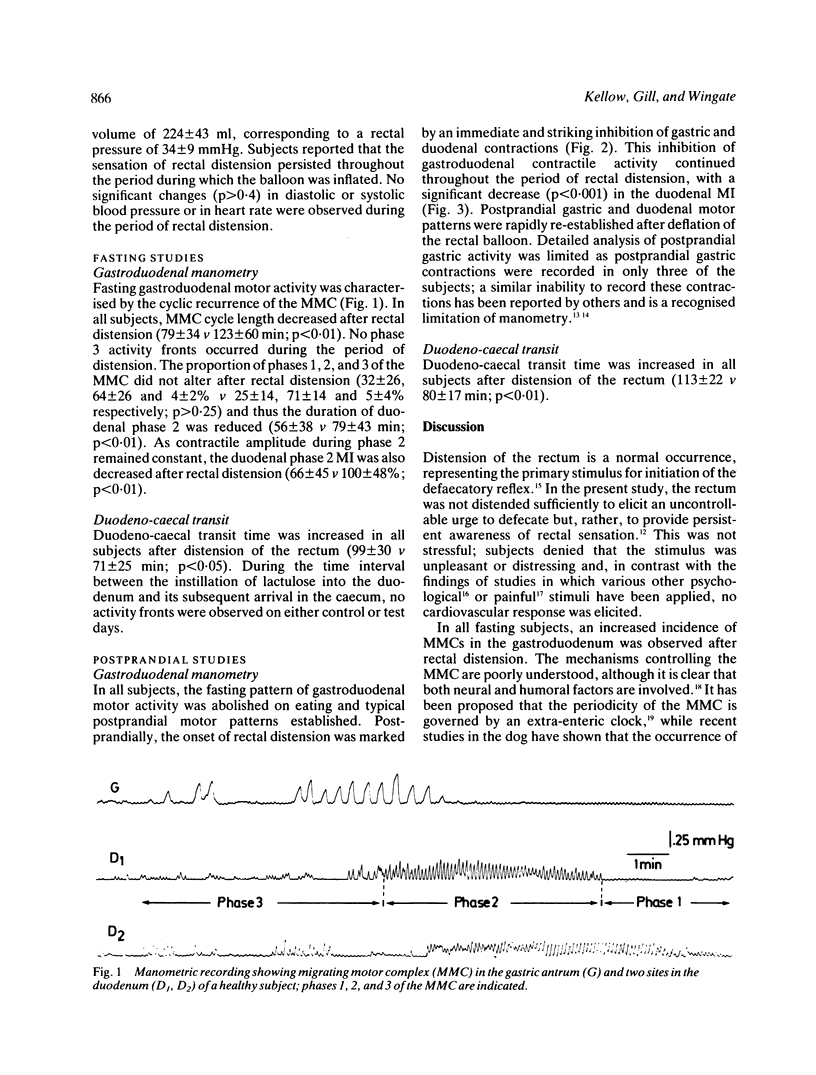
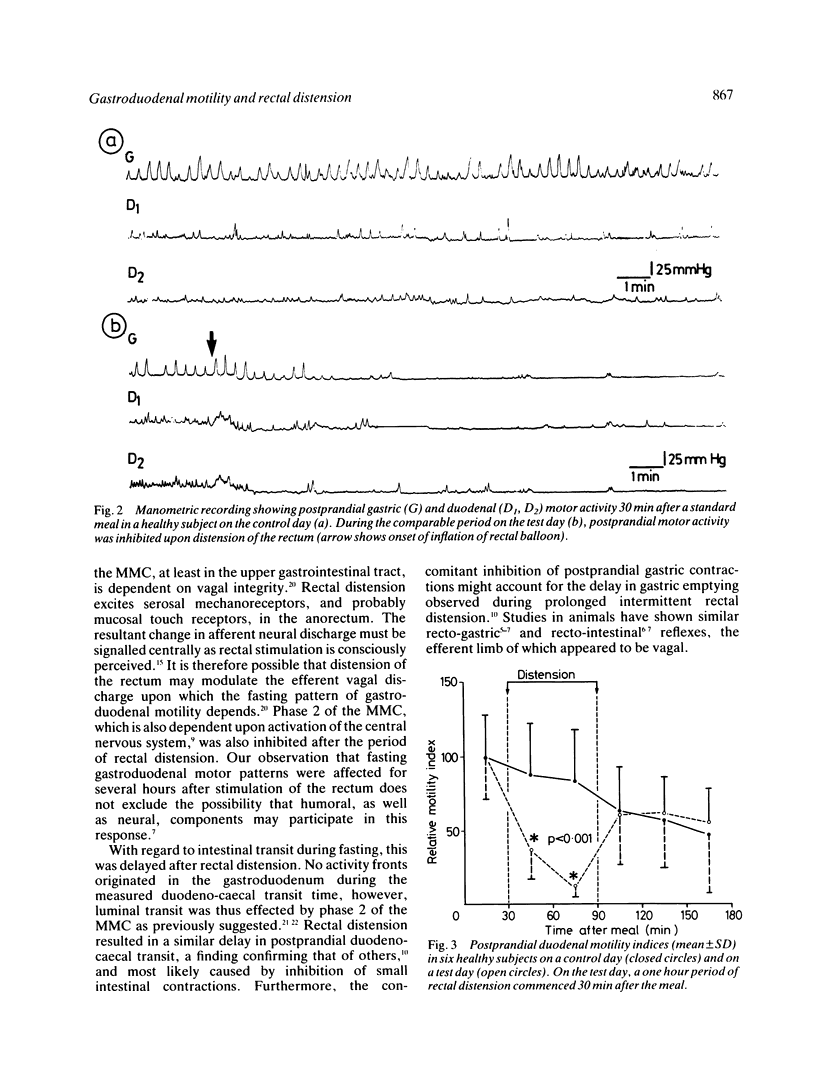
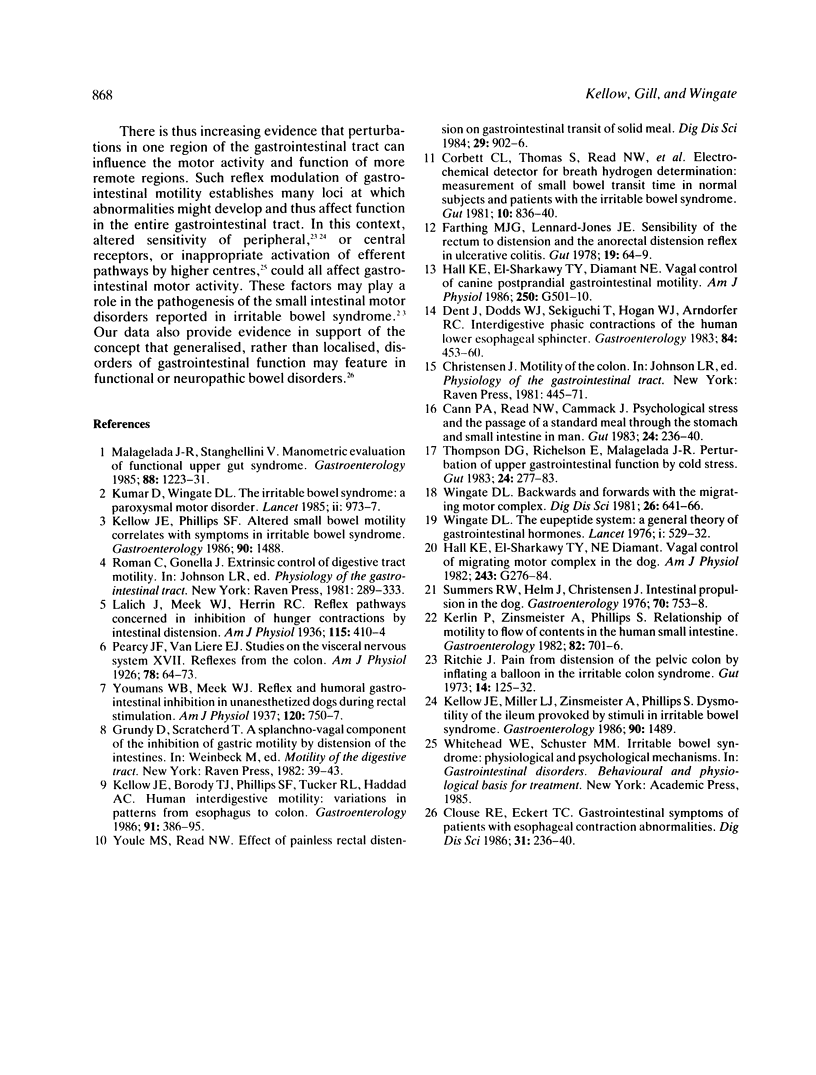
Selected References
These references are in PubMed. This may not be the complete list of references from this article.
- Cann P. A., Read N. W., Cammack J., Childs H., Holden S., Kashman R., Longmore J., Nix S., Simms N., Swallow K. Psychological stress and the passage of a standard meal through the stomach and small intestine in man. Gut. 1983 Mar;24(3):236–240. doi: 10.1136/gut.24.3.236. [DOI] [PMC free article] [PubMed] [Google Scholar]
- Clouse R. E., Eckert T. C. Gastrointestinal symptoms of patients with esophageal contraction abnormalities. Dig Dis Sci. 1986 Mar;31(3):236–240. doi: 10.1007/BF01318113. [DOI] [PubMed] [Google Scholar]
- Corbett C. L., Thomas S., Read N. W., Hobson N., Bergman I., Holdsworth C. D. Electrochemical detector for breath hydrogen determination: measurement of small bowel transit time in normal subjects and patients with the irritable bowel syndrome. Gut. 1981 Oct;22(10):836–840. doi: 10.1136/gut.22.10.836. [DOI] [PMC free article] [PubMed] [Google Scholar]
- Dent J., Dodds W. J., Sekiguchi T., Hogan W. J., Arndorfer R. C. Interdigestive phasic contractions of the human lower esophageal sphincter. Gastroenterology. 1983 Mar;84(3):453–460. [PubMed] [Google Scholar]
- Farthing M. J., Lennard-jones J. E. Sensibility of the rectum to distension and the anorectal distension reflex in ulcerative colitis. Gut. 1978 Jan;19(1):64–69. doi: 10.1136/gut.19.1.64. [DOI] [PMC free article] [PubMed] [Google Scholar]
- Hall K. E., El-Sharkawy T. Y., Diamant N. E. Vagal control of migrating motor complex in the dog. Am J Physiol. 1982 Oct;243(4):G276–G284. doi: 10.1152/ajpgi.1982.243.4.G276. [DOI] [PubMed] [Google Scholar]
- Hall K. E., el-Sharkawy T. Y., Diamant N. E. Vagal control of canine postprandial upper gastrointestinal motility. Am J Physiol. 1986 Apr;250(4 Pt 1):G501–G510. doi: 10.1152/ajpgi.1986.250.4.G501. [DOI] [PubMed] [Google Scholar]
- Kellow J. E., Borody T. J., Phillips S. F., Tucker R. L., Haddad A. C. Human interdigestive motility: variations in patterns from esophagus to colon. Gastroenterology. 1986 Aug;91(2):386–395. doi: 10.1016/0016-5085(86)90573-1. [DOI] [PubMed] [Google Scholar]
- Kerlin P., Zinsmeister A., Phillips S. Relationship of motility to flow of contents in the human small intestine. Gastroenterology. 1982 Apr;82(4):701–706. [PubMed] [Google Scholar]
- Kumar D., Wingate D. L. The irritable bowel syndrome: a paroxysmal motor disorder. Lancet. 1985 Nov 2;2(8462):973–977. doi: 10.1016/s0140-6736(85)90525-2. [DOI] [PubMed] [Google Scholar]
- Malagelada J. R., Stanghellini V. Manometric evaluation of functional upper gut symptoms. Gastroenterology. 1985 May;88(5 Pt 1):1223–1231. doi: 10.1016/s0016-5085(85)80083-4. [DOI] [PubMed] [Google Scholar]
- Ritchie J. Pain from distension of the pelvic colon by inflating a balloon in the irritable colon syndrome. Gut. 1973 Feb;14(2):125–132. doi: 10.1136/gut.14.2.125. [DOI] [PMC free article] [PubMed] [Google Scholar]
- Summers R. W., Helm J., Christensen J. Intestinal propulsion in the dog. Its relation to food intake and the migratory myoelectric complex. Gastroenterology. 1976 May;70(5 PT1):753–758. [PubMed] [Google Scholar]
- Thompson D. G., Richelson E., Malagelada J. R. Perturbation of upper gastrointestinal function by cold stress. Gut. 1983 Apr;24(4):277–283. doi: 10.1136/gut.24.4.277. [DOI] [PMC free article] [PubMed] [Google Scholar]
- Wingate D. L. Backwards and forwards with the migrating complex. Dig Dis Sci. 1981 Jul;26(7):641–666. doi: 10.1007/BF01367678. [DOI] [PubMed] [Google Scholar]
- Wingate D. The eupeptide system: A general theory of gastrointestinal hormones. Lancet. 1976 Mar 6;1(7958):529–532. doi: 10.1016/s0140-6736(76)90308-1. [DOI] [PubMed] [Google Scholar]
- Youle M. S., Read N. W. Effect of painless rectal distension on gastrointestinal transit of solid meal. Dig Dis Sci. 1984 Oct;29(10):902–906. doi: 10.1007/BF01312478. [DOI] [PubMed] [Google Scholar]


